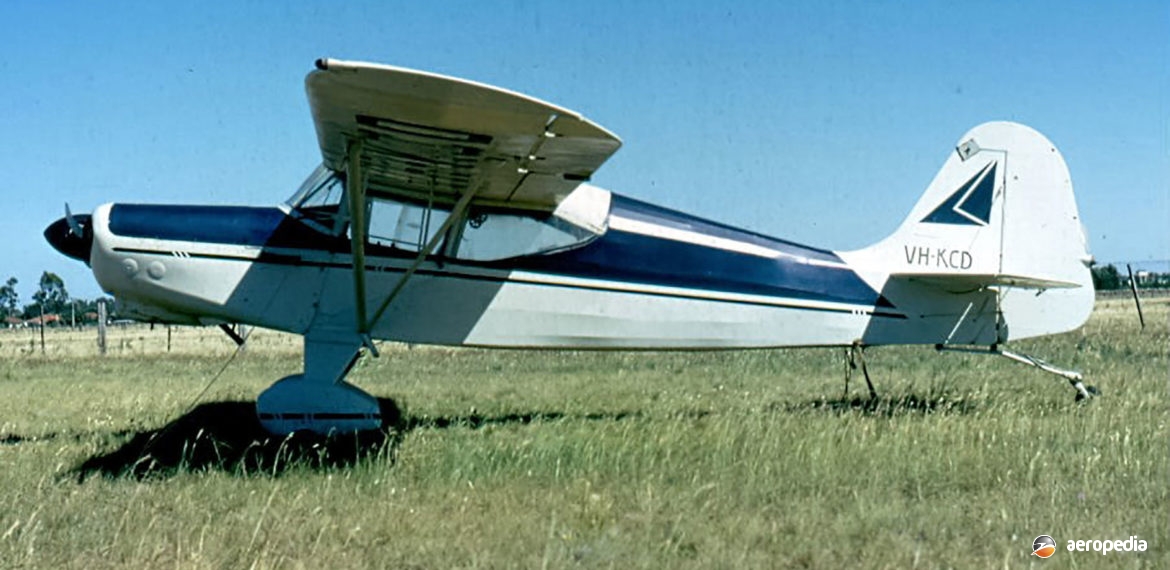Photograph:
Kingsford Smith Bushmaster VH-KCD (c/n 3189) at Echuca, VIC (David C Eyre)
Country of origin:
Australia
Description:
Light touring monoplane
Power Plant:
One 134 kw (180 hp) Lycoming O-360 four-cylinder horizontally-opposed air-cooled engine
Specifications:
- Wingspan: 10.97 m (36 ft)
- Length: 7.07 m (23 ft 2 in)
- Height: 1.98 m (6 ft 6 in)
- Wing area: 17.18 m² (185 sq ft)
- Max cruising speed at 457 m (1,500 ft): 194 km/h (121 mph)
- Economical cruising speed at 65% power: 176 km/h (109 mph)
- Best climb speed: 111 km/h (69 mph)
- Stalling speed flaps up: 63 km/h (39 mph)
- Stalling speed full flap: 41 km/h (25 mph)
- Rate of climb: 366 m/min (1,200 ft/min)
- Take-off run: 91 m (300 ft)
- Empty weight: 602 kg (1,327 lb)
- Loaded weight: 1,111 kg (2,450 lb)
History:
In 1959 Bankstown, NSW based Kingsford Smith Aviation Service Pty Ltd set up a company, Austerserve Pty Ltd, to modify and improve Austers imported from the United Kingdom. Up to that time the Company had received various Austers in knock-down form and was assembling and finishing them for sale. The Company was of the view some work could be carried out on the aircraft to make them more competitive against the wave of American-built aircraft starting to arrive.
The first aircraft of what was expected to be a small local production line was the conversion of an Auster J-5G Cirrus Autocar, VH-KCD (c/n 3189), which had formerly been fitted with a 116 kw (155 hp) Cirrus Major III engine. At the time of the conversion it had flown some 700 hours and had been based at Cobar, NSW.
The Bushmaster, as this conversion became known, was fitted with a 134 kw (180 hp) Lycoming O-360 engine driving a Hartzell constant-speed propeller, new instrumentation, more comfortable seating, extra sound proofing, a radio, and Goodyear hydraulic brakes. Whereas the Cirrus Major III engine weighed 156 kg (345 lb), the Lycoming weighed 129 kg (285 lb). Other changes included a generator, exhaust muffler and full flow oil cooler. Provision was made for hot air for the carburettor and cabin heating, and a fully castoring and steerable Scott pneumatic tailwheel was installed.
In advertising Kingsford Smith stated “the Bushmaster, an aircraft that will make history. Designed for Australian conditions, rugged, robust and reliable, low initial purchase price. A four-seat cabin aircraft fitted with a new engine of 180 hp with electric starter, and generator included. The constant speed propeller is the best in the world…compare the price, capacity and performance. There are better aeroplanes, but they cost you twice as much to purchase and maintain. Delivery – a few weeks after we receive the order”.
In the event only one aircraft was converted to Bushmaster configuration, VH-KCD, continuing in service until it overturned landing near Echuca, VIC on 25 January 1974. In 1989 the wreck was taken to Griffith, NSW, where work commenced on a rebuild.
A further similar conversion was made by Kingsford Smith to Auster J-5G Cirrus Autocar VH-ADY (c/n 2981), this aircraft being fitted with a 168 kw (225 hp) Continental O-470 engine, a constant-speed propeller, larger wheels, hydraulic brakes and other changes to suit it for agricultural work. When completed it entered service with Hazelton Air Services in western New South Wales.
It is interesting to note, prior to the conversion, this aircraft, on behalf of the Hazelton Company, flown by M/s Margaret Cornwell, who worked in the Hazelton office, with M/s N Sincotts on one flight, and with Mr E Wills on two others, made a number of long-distance non-stop flights. On these occasions the aircraft was fitted with a long-range tank holding 223 litres (49 Imp gals) in the rear cockpit, and an extra oil tank holding 9 litres (2 Imp gals).
The first of these flights was made on 31 October 1953 from Bankstown, NSW to Parafield, SA in 8 hrs 12 mins at 145 km/h (90 mph), a total distance of 1,159 km (720 miles); then on 14 November 1953 from Mascot, NSW to Eagle Farm, Brisbane, QLD covering 1,497 km (930 miles) at 181 km/h (112.7 mph) in 8 hrs 15 mins; and then on 12 December 1953 from Mascot to Broken Hill, NSW 1,867 km (1,160 miles) at 187 km (116 mph) in 10 hrs. The aircraft only remained in service for a few years before it was destroyed in a crash at Weelong, NSW on 20 March 1959.
A few other Austers have been converted to similar configuration to the Bushmaster. Auster J-5G Cirrus Autocar VH-WED (c/n 3263), after many years of service, was converted to take a Lycoming O-360 engine and was internally fitted out with modern soundproofing, the aircraft becoming known as a J-5G/A2. Another conversion was that of VH-JSG (c/n 3173), a J-5G which became known as a J-5G/A2, also fitted with a Lycoming O-360 engine.

